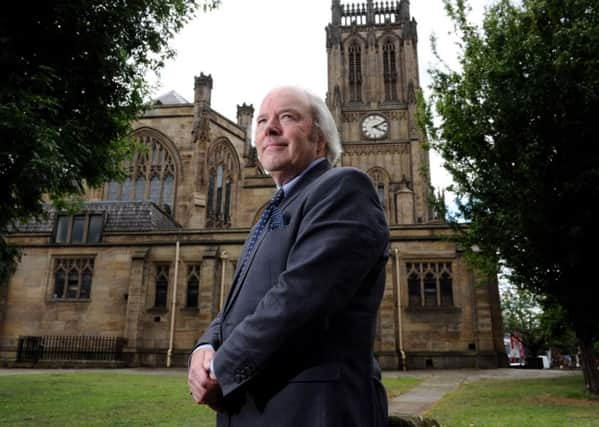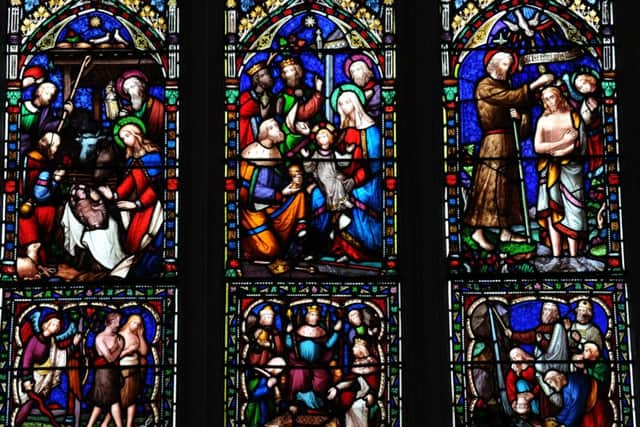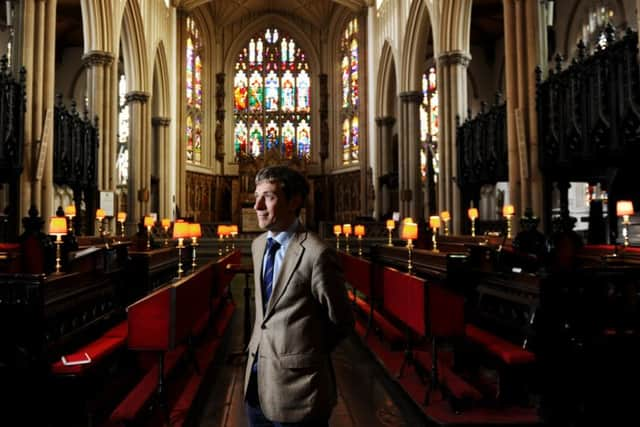Exploring the church heritage on our doorstep


A group of teenagers lounge around listlessly, laughing and smoking and enjoying the warm afternoon sunshine.
They probably have no idea that the slabs of polished stone lying just a few feet away on the railway embankment are in fact gravestones bearing the faded names of men, women and children who have long since shuffled off this mortal coil. But then neither did I. It’s just one of several nuggets of information gleaned while talking to architectural historian Dr Christopher Webster about the history of Leeds Minster across the road.
Advertisement
Hide AdAdvertisement
Hide AdIt turns out that part of the churchyard was sold so the railway viaduct we see today could be built, which is why some of the gravestones now slope up the embankment not far from Leeds train station.


Dr Webster is giving a tour and talk tomorrow entitled, The Noblest Construction in Modern Times; Building Leeds Minster, and next month the acclaimed organist Dr Simon Lindley will be discussing the relationship between music and the minster.
Both events are part of the annual Church Explorers festival, set up by the Jorvik Group, which aims to retell forgotten stories from Yorkshire’s neighbourhood churches and encourage more people to visit what organisers are calling Britain’s most undervalued heritage.
Dr Chris Tuckley, from the York Archaeological Trust which oversees the programme, points out that many people who walk past churches every day are unaware of their history.
Advertisement
Hide AdAdvertisement
Hide Ad“Our churches are like giant storybooks, made in stone, and full of amazing stories. If they were manuscripts, they would be under lock and key in national museums, the envy of the world, and yet we pass by them in our neighbourhoods, unaware of their secrets and their importance.”


What began in York has spread to places like Selby, Ripon and now Leeds. Dr Webster says Leeds Minster (formerly Leeds Parish Church) has a unique place within Church of England history.
“What we regard as quintessentially Church of England, so an altar raised on steps, choirboys in robes, two lines of choir stalls facing each other, it all starts here in Leeds. It’s that important,” he says. “It was here that it all came together and this model was copied all around the world.”
Much of this was down to the influence of Dr Walter Hook who became the church’s vicar when he arrived in the spring of 1837. Hook was a leading light in the Church of England during the mid 19th Century. “He was energetic and charismatic and because he was an important figure nationally it meant that all eyes were on Leeds,” says Dr Webster.
Advertisement
Hide AdAdvertisement
Hide AdHook quickly decided the old church, which was in a state of disrepair, needed renovating but after six months this evolved into a completely new building. The old Medieval church was demolished the following year and in 1841 the new parish church was built.


It was designed by Robert Chantrell, regarded as the foremost church architect in the north of England at the time. Hook had told him to build a ‘grand’ building that would ‘hold as many people as possible’.
The initial costs were expected to come in at around £2,500, this quickly doubled and then spiralled upwards with the final bill amounting to just shy of £30,000 – the equivalent of many millions of pounds in today’s money.
“If you were wealthy the most fashionable thing you could do was give money for a new church,” says Dr Webster. All the money came from churchgoers of all walks of life – including penny subscriptions from widows as well as larger donations from wealthy mill owners. “One of the windows was referred to as ‘the penny window’ because the stained glass was paid for by hundreds of contributions of pennies.”
Advertisement
Hide AdAdvertisement
Hide AdRichard Butterfield, director of operations and development at Leeds Minster, says the Church Explorers programme is a way of encouraging people to take a closer look at their local churches.


“Right across Yorkshire we have a real richness of church heritage and architecture. Churches are some of the oldest single body of buildings we have. You don’t have to look very far here to find some real gems that have a long, uninterrupted span of Christian worship. Leeds Minster, for example, is the fifth church that has existed on this site.”
Proof of which can be found inside the minster where you can see an Anglo-Saxon cross dating back more than a thousand years.
However, Butterfield points out that people often aren’t aware of this history. “These are some of the riches on our doorstep that we perhaps take for granted. Churches in many cases are still fulfilling their original purpose as places of worship, but they’re also places of great historical and architectural importance.”
Advertisement
Hide AdAdvertisement
Hide AdThere’s a misplaced perception among some people that churches are only for those of particular faiths and aren’t open to the public. But most are, at least some of the time, and you don’t have to be religious to come and marvel at the craftsmanship or simply enjoy a moment or two of quietude.
“The Minster is open seven days a week so visitors can come here and we put on various events and talks, as well as concerts, that perhaps reveal more of that history and heritage to people,” says Butterfield.
“The interest in places like this remains extremely high. We’ve just had 50 Chinese visitors that were in Leeds and wanted to have a look round the minster. We still get people coming in who are Leeds born and bred who had never been in here and when they come in they’re stunned and delighted by what they find.”
The minster doesn’t only hold religious interest there are other historical treasures here, too. The church boasts a series of mosaics by Salviati, the acclaimed Venetian family, whose workshop can still be found along the Grand Canal in Venice. “As 19th Century mosaics go Salviati was good as they get,” says Dr Webster.
Advertisement
Hide AdAdvertisement
Hide AdSome congregations may be dwindling these days but churches still offer an important connection with the past. “Quite apart from their religious importance they tell us so much about the history of our towns and cities.
“Many of our churches are magnificent monuments to an industrial society and Leeds Minster is every bit as important to the city’s heritage as the town hall,” he says.
“You can come in and enjoy the stained glass or the mosaics. You can take in as much or as little as you like. The doors are open, you just need to come in and take a look around.”
Dr Webster’s talk and tour is tomorrow at Leeds Minster, starting at 10.30am. Tickets cost £5. Call 0113 245 2036.
Advertisement
Hide AdAdvertisement
Hide AdFor more details about Church Explorers events log on to churchexplorers.co.uk
Rediscovering church history
Forgotten stories from 19 Yorkshire churches are being retold during this summer as part of the Church Explorers programme.
Among those taking part is St Olave’s on Marygate in York, which was mentioned in the 1055 Anglo-Saxon chronicle as the first to be dedicated to St Olaf, before any in Scandinavia.
Selby Abbey, which is also taking part, was the first monastery to be founded in the north of England after the Norman Conquest, and contains medieval features that have survived intact despite the Dissolution in 1539.
The Rt Rev Dr John Thomson, Bishop of Selby, says it’s a good way of promoting our churches: “They tell the rich stories of their communities over the generations and are still full of life today.”